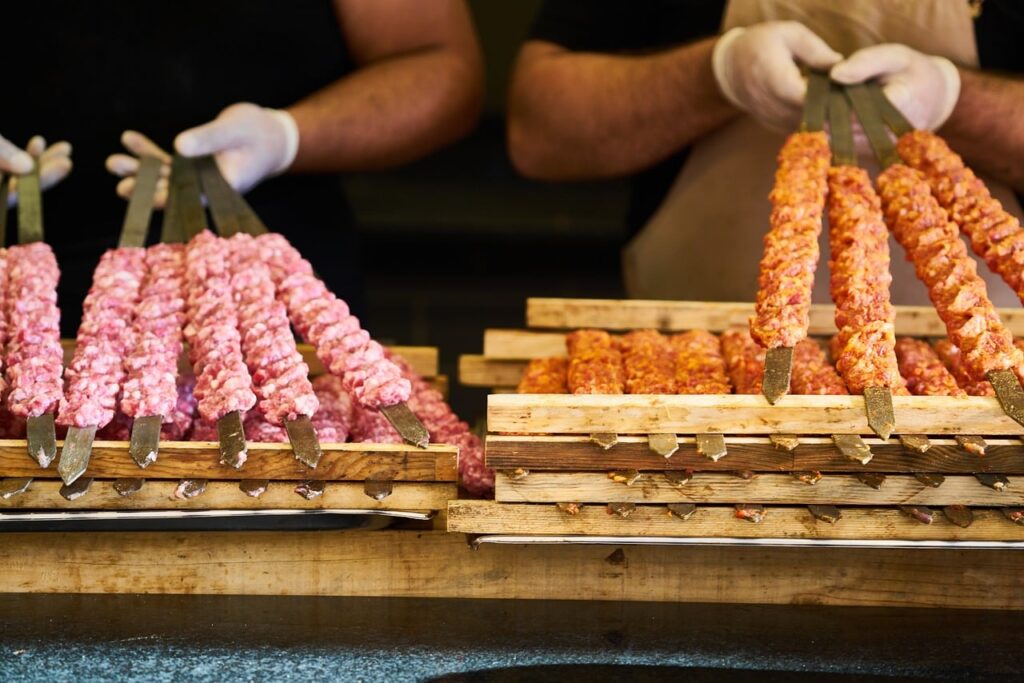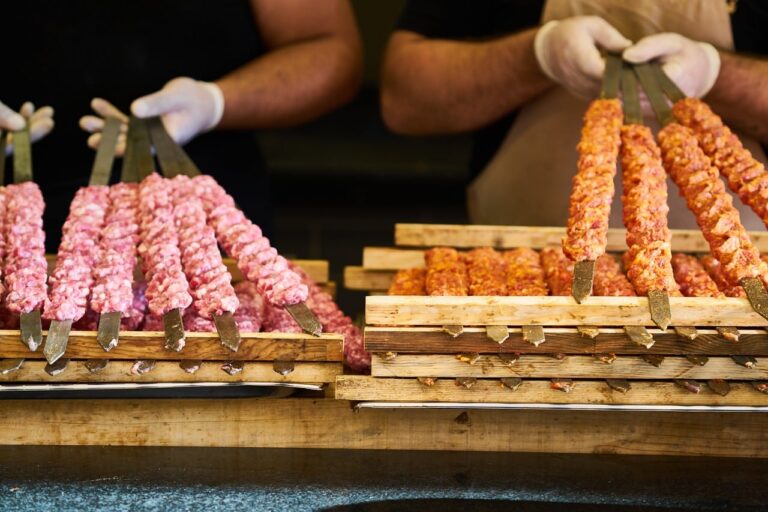
Kebab, a dish that has become synonymous with Turkish cuisine, is more than just food. It’s a symbol of culture and tradition, deeply rooted in the country’s history. This culinary delight has managed to transcend borders and become a global phenomenon.
Our team at Remitly created this guide as part of our series that celebrates the culinary cuisine of our customers around the world.
The Origin of Kebab
The kebab traces its origins back to the nomadic tribes of Central Asia. These tribesmen would skewer meat on their swords and cook it over an open fire. This method was not only practical but also efficient for their lifestyle. Over time, this cooking technique spread across various regions including Turkey.
In Turkey, the kebab evolved into something more than just skewered meat. It became an integral part of the local cuisine, with each region adding its unique twist to the dish. The diversity in Turkish geography and culture played a significant role in shaping the variety we see in Turkish kebabs today.
Ingredients and Preparation of Kebab
The primary ingredient in any kebab is meat—usually lamb or beef—but chicken and fish are also used. Vegetables such as tomatoes, peppers, and onions often accompany the meat on the skewer.
Preparation involves marinating the meat in spices before grilling it over charcoal or wood fire. The result is tender pieces of meat infused with flavors from both the marinade and smoke from the grill—a testament to simplicity yielding extraordinary results.
A Simple Recipe for Turkish Kebab
Cooking a traditional Turkish kebab at home is easier than you might think. Here’s a simple recipe to get you started.
Ingredients:
- 500g of lamb or beef, cut into cubes
- 1 large onion, finely chopped
- 2 cloves of garlic, minced
- 1 red bell pepper, diced
- 2 tomatoes, diced
- Juice of one lemon
- 2 tablespoons of olive oil
- Salt and pepper to taste
Preparation:
- In a bowl, combine the meat with the onion, garlic, bell pepper, tomatoes, lemon juice, olive oil, salt and pepper. Mix well until all the ingredients are evenly distributed.
- Cover the bowl and let it marinate in the refrigerator for at least two hours.
- After marinating, thread the meat onto skewers alternating with pieces of onion and bell pepper.
- Preheat your grill or barbecue to medium heat.
- Grill the skewers for about 10 minutes on each side or until the meat is cooked to your liking.
- Serve your homemade Turkish kebab with rice pilaf and fresh salad.
Varieties of Turkish Kebabs
Turkey boasts an array of kebabs, each distinct yet equally delicious. The Adana kebab—named after its city of origin—is made from minced lamb mixed with red pepper flakes for heat. Then there’s Urfa kebab which is similar but less spicy.
Shish kebab features chunks of marinated meat grilled on skewers while Doner kebab involves roasting seasoned meat on a vertical spit then thinly slicing it off for serving—often seen in street food stalls around Turkey.
Turkish cuisine is also rich in traditional dishes other than kebab and its variations. Here you can see a list with other famous traditional Turkish foods you should definitely try.
The Role of Kebab in Turkish Cuisine
Kebab holds a special place in Turkish cuisine. It’s not just a dish—it’s an experience. From the sizzling sound of meat on the grill to the aroma that fills the air, kebab is a sensory delight.
It’s also a social food, often enjoyed with friends and family at gatherings or celebrations. Whether it’s a simple dinner at home or a grand feast during festivities, kebabs are always on the menu.
How to Enjoy a Traditional Turkish Kebab
Enjoying a traditional Turkish kebab involves more than just eating. It starts with watching the chef expertly prepare your meal—skewering marinated meat onto rods and grilling them over an open flame.
Once ready, it’s served with sides like rice pilaf, grilled vegetables, and fresh salads. A squeeze of lemon over your kebab adds acidity that balances out the richness of the meat. And don’t forget to pair it with Ayran—a traditional yogurt-based drink—to complete your meal.
Influence of Turkish Kebabs Globally
Since the Ottoman era, numerous dishes have been influenced by Turkey and other regions once part of the Ottoman Empire. These influences are evident in the culinary traditions of neighboring countries such as Albania and Greece.
Additionally, Turkish kebabs have made their mark globally. From Europe to Asia and America, you’ll find variations of this dish adapted to local tastes while maintaining its essence.
In Germany for instance, Doner kebab has become an integral part of their fast-food culture while in India; seekh kebabs are popular street food items. This global influence speaks volumes about how food can bridge cultural gaps and bring people together.
The Broader Cuisine of Turkey
Turkish cuisine is as diverse as its landscape—rich in flavors and steeped in history.
Breakfast Culture
Breakfast in Turkey is an elaborate affair often featuring cheese varieties like feta and kashkaval along with olives, honeycomb with clotted cream (known as kaymak), eggs prepared in various ways and breads like simit—a sesame encrusted circular bread.
Meze: The Art of Small Plates
Meze refers to an array of small dishes served before a main meal—akin to appetizers but more extensive. It includes items like hummus (chickpea dip), dolma (stuffed vine leaves), cacik (yogurt with cucumber and garlic), and much more.
Seafood Delights
Given its extensive coastline, seafood plays a significant role in Turkish cuisine. Grilled fish, calamari, and mussels stuffed with spiced rice are common dishes.
Sweet Treats
Turkish desserts are renowned worldwide. Baklava—layers of filo pastry filled with nuts and drenched in syrup—is a favorite. Turkish delight or Lokum—a gel-like sweet dusted with powdered sugar—is another popular treat.
In essence, Turkish cuisine is a gastronomic adventure that offers something for everyone—from hearty meat dishes to fresh seafood delights, from vibrant mezes to decadent sweets. It’s a culinary tradition that invites you to sit down, take your time, and savor every bite.
Visit the homepage, download our app, or check out our Help Center to get started.
